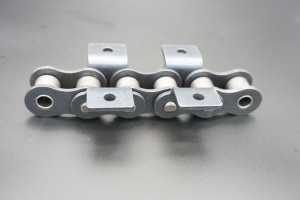Visual inspection of the chain
1. Whether the inner/outer chain is deformed, cracked, embroidered
2. Whether the pin is deformed or rotated, embroidered
3. Whether the roller is cracked, damaged or excessively worn
4. Is the joint loose and deformed?
5. Whether there is any abnormal sound or abnormal vibration during operation, and whether the chain lubrication is in good condition
Testing method
Chain length accuracy should be measured according to the following requirements:
1. The chain is cleaned before measurement
2. Wrap the tested chain around the two sprockets, and the upper and lower sides of the tested chain should be supported
3. The chain before measurement should stay for 1min under the state of applying one-third and the minimum ultimate tensile load
4. When measuring, apply the specified measuring load on the chain, so that the chains on the upper and lower sides are tensioned, and the chain and the sprocket should ensure normal toothing
5. Measure the center distance between the two sprockets
To measure chain elongation:
1. In order to remove the play of the entire chain, it should be measured under a certain degree of pulling tension on the chain
2. When measuring, in order to minimize the error, measure at 6-10 knots
3. Measure the inner L1 and outer L2 dimensions between the number of rollers to obtain the judgment size L=(L1+L2)/2
4. Find the elongation length of the chain. This value is compared with the use limit value of the chain elongation in the previous item.
Chain structure: composed of inner and outer links. It is composed of five small parts: inner chain plate, outer chain plate, pin shaft, sleeve, and roller. The quality of the chain depends on the pin shaft and sleeve.
Post time: Aug-29-2023

